幒撪旘峴婡丂奺庬嫞媄庬栚婯掕乮儖乕儖乯廤
偛偔尷傜傟偨婡庬偩偗偱偡偑丄埬奜Internet忋偵偼尒偮偗偵偔偄偺偱嫇偘偰偍偒傑偡丅
摿婰側偒榓栿偼廐尦偵傛傞傕偺偱偡丅
側偍悘帪尨揟傪嶲峫偵梊崘柍偔夵掶偡傞偙偲偑偁傝傑偡偺偱偛拲堄偔偩偝偄丅
傑偨丄偙偙偵嵹偭偰側偄乽F1D乿乽F1L乿乽F1M乿摍偼嶰搰僼儕乕僼儔僀僩偺web僒僀僩傪偛棗偔偩偝偄丅
仭A-6仭
仭HK-28仭
仭HK-35仭 2011/11寧捛婰
仭儅儞僴僢僞儞仭
仭儃僗僩僯傾儞仭
仭僙僀儞僩丒僼僅乕儈儏儔(彲撪僺乕僫僢僣丒僼僅乕儈儏儔)仭
仭儁僯乕丒僾儗乕儞仭
仭揤堜崅偝偵傛傞嬫暘仭
仭A-6仭(傾儊儕椡丗FAI傗AMA偺惓幃庬栚偱偼側偄偑斾妑揑晛媦偟偰偄傞)
丂>丂1. Maximum projected wing area 30 sq. inches. To facilitate area
丂>丂丂 processing a dimensioned wing outline drawing with area calculations
丂>丂丂 shall be provided to the CD.
丂丂搳塭偝傟偨嵟戝庡梼柺愊偼 30暯曽僀儞僠(193.54暯曽cm)偱丄
丂丂偦偺椫妔偼嫞媄愑擟幰(Contest Director)偵偲偭偰梼柺愊偺寁嶼偑梕堈偱偁傞偙偲丅
丂>丂2. All wing, rudder & stabilizer construction including wing &
丂>丂丂 stabilizer posts shall be 1/16" Sq. minimum, except ribs. Minimum rib
丂>丂丂 size shall be 1/32" X 1/16". Posts may be rounded only in the area of
丂>丂丂 mounting tubes, if used.
丂丂儕僽傪彍偔偡傋偰偺庡梼丒悈暯旜梼丒悅捈旜梼偍傛傃偦傟傜偺巟拰偼丄
丂丂嵟彫1/16僀儞僠妏亂傑偨偼1.5mm妏亃偱側偗傟偽側傜側偄丅
丂丂儕僽偺嵟彫(抐柺)僒僀僘偼1/16亊1/32僀儞僠(1.58mm亊0.8mm亂傑偨偼1.5mm亊1.0mm亃)偲偡傞丅
丂丂巟拰偼丄僠儏乕僽偵愙懕偡傞晹暘偺傒娵傔傞(妏傪庢傞)偙偲偑偱偒傞丅
丂>丂3. Propeller 6-inch maximum diameter.丂Blades to be flat 1/32"
丂>丂丂 minimum sheet wood, no forming (no twist or camber).
丂丂僾儘儁儔偺嵟戝捈宎偼 6僀儞僠(15.2cm)丅
丂丂僽儗乕僪偼嵟彫岤偝1/32僀儞僠(0.8mm)亂傑偨偼1mm亃偺暯傜側栘惢偺斅嵽偱丄
丂丂(傂偹偭偨傝梼抐柺偵側傞傛偆側)惉宍偼晄壜丅
丂丂
丂>丂4. Maximum motor stick length 6 inches measured from the thrust
丂>丂丂 bearing face to the rear hook.
丂丂僗儔僗僩儀傾儕儞僌偺慜柺偐傜儕傾僼僢僋(屻晹僑儉偐偗)傑偱偺儌乕僞乕僗僥傿僢僋
丂丂偺嵟戝挿偼6僀儞僠(15.2cm)丅
丂>丂5. Weight 1.2 grams minimum without rubber.
丂丂僑儉傪彍偄偨 嵟戝 嵟彫廳検 偼1.2g
丂>丂6. Covering: tissue, condenser paper, gampi. No plastic.
丂丂旐暍丗巻丄僐儞僨儞僒乕儁乕僷乕丄婂旂巻偱偁傞偙偲丅僾儔僗僥傿僢僋僼傿儖儉偼晄壜丅
丂>丂7. No High tech materials including boron, carbon, Kevlar and foam.
丂丂儃儘儞丄僇乕儃儞丄働僽儔乕丄敪朅嵽側偳偺崅婡擻慺嵽偼巊梡偱偒側偄丅
丂>丂8. Rubber powered.
丂丂僑儉摦椡偱偁傞偙偲丅
丂乮尨暥偼抙忋彶岹偝傫偺帒椏傛傝丅側偍亂 亃偺晹暘偼儊乕僩儖朄偵攝椂偟捛壛偝傟偨傕偺丅乯
仭HK-28仭乮崱偺偲偙傠擔杮崙撪偺堦晹偱峴側傢傟偰偄傞乯
丂丂1.廳検
丂丂丂丂嵟掅廳検(僑儉彍偔)丂仺丂2.0g埲忋
丂丂2.庡梼
丂丂丂丂僗僷儞(梼暆亖搳塭)丂仺丂嵟戝280mm
丂丂丂丂僐乕僪(梼尫挿)丂丂丂仺丂嵟戝 65mm
丂丂3.旜梼
丂丂丂丂僗僷儞丒僐乕僪丂丂丂仺丂婯惂柍偟丄偨偩偟丄旜梼柺愊偼嵟戝偱庡梼柺愊偺1/2埲壓
丂丂4.摲懱
丂丂丂丂慡挿丂丂丂丂丂丂丂丂仺丂300mm埲壓(僾儘儁儔彍偔)
丂丂丂丂儌乕僞乕僗僥傿僢僋(婡庱愭抂偐傜屻晹僑儉僼僢僋傑偱)丂仺丂嵟戝180mm埲壓
丂丂5.偦偺懠
丂丂丂丂僑儉搵嵹検丒僾儘儁儔悺朄丒嵽椏側偳丂仺丂婯惂側偟丅
乮HK-28偺嶌椺乯
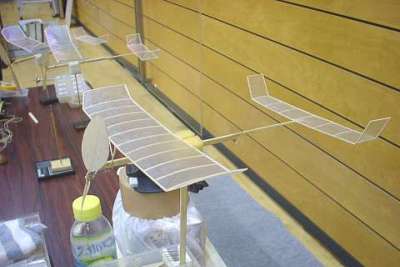 丂
丂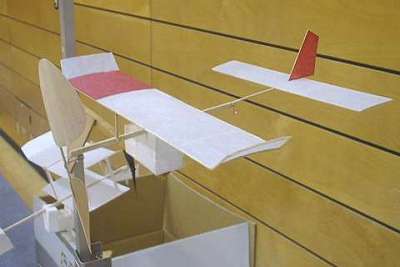
丂丂丂HK-28偼乽強戲僼僃僓乕僾儗乕儞僋儔僽乿慜夛挿丗彫枔徃巵(2009擭2寧偛惱嫀)偺峫埬偵傛傞弶怱幰岦偗婯奿偱偡丅
丂丂丂巹尒偱偡偑丄弶怱幰岦偗丄傑偨偼晛媦梡偺婯奿偲偟偰偼A-6偵偔傜傋偄偔偮偐偺揰偱桪傟偰偄傑偡丅
丂丂丂A-6偲偺戝偒側堘偄偼丄乽嵟掅廳検偑廳偄偙偲乿偲丄乽嵽椏偺惂尷偑側偄乿偙偲偱偡丅
丂丂丂嵟掅廳検偼A-6偺1.2g偵懳偟丄HK-28偼 2.0g埲忋偲側偭偰偄傑偡丅
丂丂丂A-6偼嵽椏悺朄偑1.5mm妏嵽傗0.8mm岤偺斅嵽偵尷傜傟丄偙偺悺朄偺嵽椏偱偺忋婰1.2g幚尰偼帄擄偺嬈偱偡丅
丂丂丂傑偨丄偦傕偦傕嵟嬤偺擔杮崙撪偱偼1.5mm岤偺僶儖僒帺懱偑梕堈偵庤偵擖傜側偄偺偱偡丅
丂丂丂傑偟偰丄忋婰1.2g偺幚尰偵偼偦偺拞偱傕摿偵嫮搙佁廳検斾偵桪傟偨崅昳幙側僶儖僒嵽偑昁梫偱偡丅
丂丂丂偙傟偱偼丄婡懱惢嶌埲慜偵丄嵽椏擖庤偺彑晧偵側偭偰偟傑偄傑偡丅
丂丂丂HK-28偼嵽椏偵惂栺偑偁傝傑偣傫偺偱丄傑偩擖庤偟傗偡偄1mm岤傗2mm岤偺僶儖僒傕巊偊傑偡偟丄
丂丂丂2.0g偲偄偆廳検惂栺側傜丄偁傑傝恄宱幙偵側傜側偔偰傕廫暘偵幚尰壜擻側抣偩偲巚偄傑偡丅
丂丂丂(僶儖僒嵽偺崪慻傒偑廳傔偵側偭偨傜丄旐暍嵽偵僼傿儖儉傪巊偭偰寉検壔傪恾傞丄偲偄偆曽岦傕壜擻偱偡)
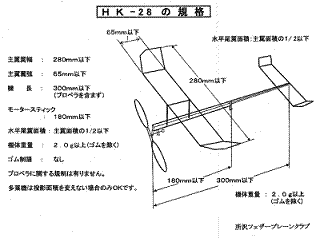
丂丂丂堦曽丄僾儘儁儔偺悺朄偲峔憿偵惂尷偑側偄偨傔丄弉楙幰偱偁傟偽偦偺晹暘偵拲椡偟偨惈擻岦忋偑壜擻偱偡丅
丂丂丂幚嵺丄弉楙幰偺婡懱偵偼壜曄僺僢僠婡峔偑巊傢傟偰偄傑偡丅
丂丂丂偨偩偟偳傫側婡峔傪巊偍偆偲丄梼柺愊偲嵟掅廳検惂尷偑摨偠偱偡偐傜丄懾嬻帪娫偺嵟戝梫慺偱偁傞梼柺壸廳偼丄
丂丂丂偳偺婡懱偱傕傎傏摨偠抣偵廂傟傫偟傑偡丅
丂丂丂偮傑傝丄嬻椡摿惈揑偵偼弶怱幰傕弉楙幰傕傎偲傫偳摨偠婡懱偵側傞婯奿偱偁傝側偑傜丄弶怱幰偼弶怱幰側傝偵丄
丂丂丂傑偨弉楙幰偼弉楙幰側傝偵岺晇偺梋抧傕戝偒偄丄偲偄偆偺偑HK-28偺摿挿偲尵偊傑偡丅
丂丂丂晛媦梡婯奿偲偟偰HK-28偑桪傟偰偄傞偲巹偑峫偊傞棟桼偑丄埲忋偱偍傢偐傝偄偨偩偗傞傕偺偲巚偄傑偡丅
仭HK-35仭乮崱偺偲偙傠擔杮崙撪偺堦晹偱峴側傢傟偰偄傞乯
-
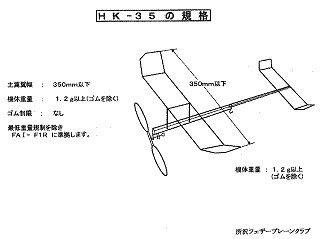
丂1.廳検
丂丂丂嵟掅廳検(僑儉彍偔)丂仺丂1.2g埲忋
丂2.庡梼
丂丂丂僗僷儞(梼暆亖搳塭)丂仺丂嵟戝350mm
丂3.偦偺懠
丂丂丂旜梼丄摲懱側偳丂丂丂仺丂婯惂柍偟
丂丂丂HK-35偼丄HK-28摨條乽強戲僼僃僓乕僾儗乕儞僋儔僽乿偵傛傞婯奿偱偡丅
丂丂丂堦尒偟偰偍傢偐傝偲巚偄傑偡偑丄HK-28偐傜廳検傗旜梼丒摲懱側偳偵娭偡傞惂栺偑戝暆偵庢傝彍偐傟偰偄傑偡丅
丂丂丂偙偺寢壥偱偒偁偑傞婡懱偼幚幙揑偵乽彮偟彫傇傝偺F1L傑偨偼F1R乿偱偁傝丄傛傝杮奿揑側幒撪婡偺摿惈傪帵偟傑偡丅
丂丂丂2011擭11寧尰嵼丄偮偔偽偱傕悢椺偑旘峴偟巒傔偰偄傑偡偑丄弶怱幰乣拞媺幰儗儀儖偺曽偱傕晛捠偵6乣7暘偑弌傑偡丅
丂丂丂崱屻偺敪揥偑妝偟傒側婯奿偲尵偊傑偡丅
仭Manhattan Cabin仭儅儞僴僢僞儞僉儍價儞(傾儊儕僇丗AMA庬栚)

丂擔杮偱偼乽儅儞僴僢僞儞僼僅乕儈儏儔乿偲偄偆屇傃曽偺傎偆偑堦斒揑側婥偑偟傑偡偑丄
丂惓幃偵偼乽儅儞僴僢僞儞僉儍價儞乿偩偦偆偱偡丅
丂>丂20.1. General. All rules applying to Free Flight Indoor Rubber,
丂>丂丂丂丂with the exceptions noted below, shall apply.
丂>丂丂丂丂壓婰偺拲庍埲奜偼僼儕乕僼儔僀僩幒撪僑儉摦椡柾宆偺堦斒婯懃偑揔梡偝傟傞丅
丂>丂20.2. Characteristics.
丂>丂丂丂丂婡懱偺摿惈
丂>丂 20.2.1. Airframe weight without rubber shall be four (4) grams minimum.
丂>丂丂丂丂丂 摦椡僑儉傪彍偔婡懱偺廳検偼嵟彫偱傕4g偁傞偙偲丅
丂>丂 20.2.2. The overall length of the model,measured without the prop, shall not exceed 20
丂>丂丂丂丂丂 inches (50.8 centimeters).
丂>丂丂丂丂丂 僾儘儁儔傪彍偔柾宆偺嵟戝悺朄偼50.8cm傪挻偊側偄偙偲丅
丂>丂 20.2.3. The fuselage must meet the following requirements.
丂>丂丂丂丂丂 摲懱偼師偺梫媮傪枮偨偡偙偲丅
丂>丂丂20.2.3.1. It must support and enclose a single rubber motor. No rigid internal structures
丂>丂丂丂丂丂丂丂such as motor sticks allowed.
丂>丂丂丂丂丂丂丂摲懱偼摦椡僑儉偺傒傪曪埻偟曐帩偡傞偙偲丅
丂>丂丂丂丂丂丂丂儌乕僞乕僗僥傿僢僋偺傛偆側峝惈偺撪晹峔憿暔偼嫋偝傟側偄丅
丂>丂丂20.2.3.2. The external structural members of the fuselage must include a theoretical box
丂>丂丂丂丂丂丂丂measuring 2.5 inches x four (4) inches x two (2)inches (6.35 x, 10.16 x 5.08
丂>丂丂丂丂丂丂丂centimeters), or larger.
丂>丂丂丂丂丂丂丂摲懱峔憿偺奜曈偼丄6.35cm亊10.16cm亊5.08cm埲忋偺捈曽懱傪娷傓偙偲丅
丂>丂丂20.2.3.3. The fuselage must include a windshield of two (2) square inches minimum area
丂>丂丂丂丂丂丂丂and a window on each side of one (1) square inch minimum; windshield and windows
丂>丂丂丂丂丂丂丂to be cellophane or similar transparent material. If transparent covering is used
丂>丂丂丂丂丂丂丂on the fuselage, then the windshield and windows must be outlined in a contrasting
丂>丂丂丂丂丂丂丂color.
丂>丂丂丂丂丂丂丂摲懱偼嵟彫偱傕崌寁2暯曽僀儞僠(栺12.9暯曽cm=惓曽宍偵偟偰栺3.6亊3.6cm)偺憢傪帩偪丄
丂>丂丂丂丂丂丂丂偦偺憢偼彮側偔偲傕1暯曽僀儞僠偢偮椉懁偵攝抲偝傟偰偄傞偙偲丅憢偺旐暍嵽偼僙儘僴儞
丂>丂丂丂丂丂丂丂傑偨偼摨摍偵摟柧側嵽椏偱偁傞偙偲丅傕偟摟柧慺嵽偑摲懱偵巊傢傟傞応崌丄憢偺晹暘偼
丂>丂丂丂丂丂丂丂怓偵傛偭偰嬫暿偱偒傞偙偲丅
丂>丂 20.2.4. The propeller shall be all wood except for shaft and hook for rubber attachment,
丂>丂丂丂丂丂 with fixed pitch and directly driven by the rubber motor.
丂>丂丂丂丂丂 僾儘儁儔偼丄摦椡僑儉愙懕晹偺僔儍僼僩偍傛傃僼僢僋傪彍偒偡傋偰栘惢偲偟丄屌掕僺僢僠偱丄
丂>丂丂丂丂丂 摦椡僑儉偵傛傝捈愙嬱摦偝傟傞傕偺偱偁傞偙偲丅
丂>丂 20.2.5. The wing shall be a monoplane with 20 inches (50.8 centimeters) maximum projected
丂>丂丂丂丂丂 span and four (4) inches (10.16 centimeters) maximum chord.
丂>丂丂丂丂丂 庡梼偼扨梩偲偟丄揥奐挿搳塭帪偺挿偝偵偍偄偰嵟戝梼暆50.8cm丄嵟戝梼尫10.16cm傑偱偲偡傞丅
丂>丂 20.2.6. The horizontal stabilizer shall be a monoplane with 12 inches (30.48 centimeters)
丂>丂丂丂丂丂 maximum projected span and 3.5 inches (8.89 centimeters) maximum chord.
丂>丂丂丂丂丂 悈暯旜梼偼扨梩偲偟丄揥奐挿搳塭帪偺挿偝偵偍偄偰嵟戝梼暆30.48cm丄嵟戝梼尫8.89cm傑偱偲偡傞丅
丂>丂 20.2.7. Wood bracing of wing and horizontal stabilizer is allowed.
丂>丂丂丂丂丂 庡梼偲悈暯旜梼偵偼栘惢偺曗嫮嵽偑嫋偝傟傞丅
丂>丂 20.2.8. The landing gear shall be fixed and rigid with at least two (2) freely turning wheels
丂>丂丂丂丂丂 of one (1) inch (2.54 centimeters) minimum diameter; the landing gear shall be able
丂>丂丂丂丂丂 to support the airplane at rest on the takeoff area.
丂>丂丂丂丂丂 拝棨媟偼彮側偔偲傕俀偮偺帺桼夞揮偡傞2.54cm埲忋偺捈宎偺幵椫傪帩偪丄屌掕偝傟偨峝幃偺
丂>丂丂丂丂丂 傕偺偱側偗傟偽側傜側偄丅偦偺拝棨媟偼棧棨僄儕傾偵偍偄偰婡懱傪巟偊傞偙偲偑偱偒傞傕偺
丂>丂丂丂丂丂 偱偁傞偙偲丅
丂>丂 20.2.9. All covering of the model except for the windows shall be paper or commercially
丂>丂丂丂丂丂 available plastic; no microfilm allowed.
丂>丂丂丂丂丂 偙偺柾宆偱偼丄憢傪彍偔慡偰偺旐暍嵽偼丄巻傑偨偼巗斕偱擖庤壜擻側僾儔僗僥傿僢僋偲偟丄
丂>丂丂丂丂丂 儅僀僋儘僼傿儖儉偼嫋偝傟側偄丅
丂>丂 20.2.10. Scoring. All flights shall rise off the ground from at least a two-point starting
丂>丂丂丂丂丂 position; the best single flight of an unlimited number of official flights shall count.
丂>丂丂丂丂丂 At the discretion of the Contest Director, the best single flight of five (5) official
丂>丂丂丂丂丂 flights shall be counted.
丂>丂丂丂丂丂 慡偰偺旘峴偼丄彮側偔偲傕2揰(偱愙抧偟偨)敪峲巔惃傪傕偭偰抧忋敪恑偟側偗傟偽側傜側偄丅
丂>丂丂丂丂丂 柍惂尷偺岞幃旘峴夞悢偺偆偪儀僗僩偺1夞傪婰榐偲偡傞丅
丂>丂丂丂丂丂 嫞媄愑擟幰偺愰尵偵傛傝丄5夞偺岞幃旘峴偺偆偪儀僗僩偺1夞傪婰榐偲偡傞偙偲傕偱偒傞丅
丂乮尨暥偼AMA Competition Regulations 2007-2008 Rules Governing Model Aviation Competition in the United States丂傛傝乯
嶲峫仭儅儞僴僢僞儞丒僼僅乕儈儏儔1976仭乮弌揟丗乽U僐儞媄弍乿'77.10寧崋乯
丂忋婰偺乽Manhattan Cabin乿偺尨宆儖乕儖偱偡偑丄2007-2008偺嵟怴斉偲偼嵶晹偱堎側偭偰偄傑偡丅
丂>丂1.慡挿
丂>丂丂僾儘儁儔幉庴偺慜柺偐傜旜抂傑偱寁應偟偨挿偝偑20僀儞僠(508mm)傪挻偊偰偼側傜側偄丅
丂>丂2.摲懱
丂>丂丂a)婡懱偵偼2亊2.5亊4僀儞僠(51亊64亊102mm)偺悺朄傪傕偮儃僢僋僗傪娷傑側偗傟側側傜側偄丅
丂>丂丂b)摲懱傪僟僀儎儌儞僪宆偵嶌傞偙偲偼嫋偝傟側偄丅忋婰儃僢僋僗偺2.5僀儞僠(64噊)偼丄悅捈
丂>丂丂丂曽岦偵庢傜側偗傟側側傜側偄丅
丂>丂丂c)摲懱慜柺偵偼嵟彫柺愊2暯曽僀儞僠(13噋^2)偺晽杊丄摲懱椉懁柺偵偼嵟彫柺愊1暯曽僀儞僠
丂>丂丂丂(6.5噋^2)偺憢傪晅偗側偗傟偽側傜側偄丅
丂>丂丂丂偙傟傜偼偡傋偰僙儘僼傽儞傑偨偼椶帡偺嵽椏偱嶌傜側偗傟偽側傜側偄丅
丂>丂3.摦椡
丂>丂丂扨敪摦椡偵尷傞丅摦椡僑儉偼摲懱偵暍傢傟丄僑儉偺椡偼摲懱偵傛偭偰庴偗側偗傟偽側傜側偄丅
丂>丂丂摦椡僑儉偺椡傪庴偗傞偨傔偵僗僥傿僢僋(朹)傪巊梡偡傞偙偲偼嫋偝傟側偄丅
丂>丂4.僾儘儁儔
丂>丂丂慡僶儖僒偲偡傞(EZB乧僀乕僕乕B偲摨偠)丅僺僢僠傑偨偼捈宎傪曄壔偝偣傞婡夿憰抲傪晅偗傞
丂>丂丂偙偲偼嫋偝傟側偄丅
丂>丂5.拝棨憰抲
丂>丂丂嵟彫捈宎1僀儞僠(25mm)偺幵桝傪彮側偔偲傕2屄庢傝晅偗側偗傟偽側傜側偄丅
丂>丂丂媟偼屌掕幃偱,抏椡惈偺側偄嵽幙偱嶌傜傟偰偄側偗傟偽側傜側偄丅
丂>丂丂拝棨憰抲偼婡懱傪巟偊傞偵廩暘側嫮偝傪傕偭偰偄側偗傟偽側傜側偄丅
丂>丂丂旘峴偼偡傋偰丄3揰巔惃偐傜偺R.O.G(抧忋弌敪)偲偡傞丅
丂>丂6.庡梼
丂>丂丂扨梩偵尷傞丅挘慄偵傛偭偰梼傪巟偊傞偙偲偼嫋偝傟側偄丅
丂>丂丂悺朄偼搳塭偟偨抣傪偲傝,嵟戝僗僷儞20僀儞僠(508噊),嵟戝梼尫4僀儞僠(102噊)偲偡傞丅
丂>丂7.悈暯旜梼
丂>丂丂悺朄偼搳塭偟偨抣傪偲傝,嵟戝僗僷儞8僀儞僠(203噊),嵟戝梼尫3.5僀儞僠(89噊)偲偡傞丅
丂>丂8.旐暍
丂>丂丂晽杊偲憢傪彍偒丄旐暍嵽椏偼巻偱側偗傟偽側傜側偄丅敄巻偲僐儞僨儞僒乕丒儁乕僷偼擣傔傜
丂>丂丂傟傞偑丄儅僀僋儘儔僀僩側偳偺旐暍嵽椏偺巊梡偼嫋偝傟側偄丄
丂>丂9.丂廳検
丂>丂丂僑儉傪彍偔婡懱偩偗偺嵟彫廳検偼4僌儔儉偲偡傞丅
丂>丂丂(拲:偙偺廳検偺扨埵偩偗偼尨杮偱傕僌儔儉傪巊偭偰偄傑偡)丅
丂>丂
仭22. Bostonian. 仭儃僗僩僯傾儞 (傾儊儕僇丗AMA庬栚)
丂儅儞僴僢僞儞傛傝堦夞傝彫怳傝側僉儍價儞宆偺婯奿偱偡丅
丂>丂22.1. General. All rules applying to FF Indoor Rubber, with the exceptions noted below,
丂>丂丂丂丂 shall apply.
丂>丂丂丂丂 壓婰偺拲庍埲奜偼僼儕乕僼儔僀僩幒撪僑儉摦椡柾宆偺堦斒婯懃偑揔梡偝傟傞丅
丂>丂22.2. Intent of Rule. This is an event to promote indoor flying of realistic propeller-driven,
丂>丂丂丂丂 rubber-powered models of a size and complexity which are suitable for small buildings
丂>丂丂丂丂 and limited skills. It also allows fanciful designs, for which no full-size counterpart
丂>丂丂丂丂 exists, to be flown.
丂>丂丂丂丂 儖乕儖偺栚揑偵偮偄偰丅
丂>丂丂丂丂 偙傟偼尷傜傟偨媄検偱斾妑揑彫偝偔嶌傞偙偲偑偱偒傞丄僾儘儁儔偵傛傞僑儉摦椡柾宆(旘峴婡)偺
丂>丂丂丂丂 僀儀儞僩傪峴側偆偨傔偺丄悺朄偍傛傃峔惉懱偵偮偄偰偺婯懃偱偁傞丅
丂>丂丂丂丂 傑偨丄旘峴偺偨傔偵偼(偙偺婯懃偺)姰慡側暋惢暔偱偁傞昁梫偼側偔丄憐憸揑僨僓僀儞偼嫋偝傟傞丅
丂>丂丂丂丂
丂>丂22.3. Charisma Judging. A 乬charisma factor乭 of 1.00 through 1.20 will be awarded each
丂>丂丂丂丂 airplane before flight, based on the purpose stated above. The assignment of charisma
丂>丂丂丂丂 factor will be made with all the models grouped together so they can be ranked and
丂>丂丂丂丂 compared. There is no reason to award either a 1.00 or a 1.20 score to any of the models
丂>丂丂丂丂 in a particular competition. These numbers represent the limits of the range to be used.
丂>丂丂丂丂 The judge is encouraged to assign values with at least two (2) significant numbers to
丂>丂丂丂丂 the right of the decimal point to fully use the factor to differentiate among the models
丂>丂丂丂丂 being judged. This factor will be awarded with whatever weighting the appointed charisma
丂>丂丂丂丂 judge sees fit and is not to be the subject of protest after judging.
丂>丂丂丂丂 Argument about charisma scoring will be considered unsportsmanlike conduct with penalties
丂>丂丂丂丂 provided in this book.
丂>丂丂丂丂 僇儕僗儅僕儍僢僕偵偮偄偰丅
丂>丂丂丂丂 僇儕僗儅梫慺偼丄忋弎偺栚揑偺偨傔偵婡懱偛偲偵1.00乣1.20偺娫偱旘峴慜偵梌偊傜傟傞丅
丂>丂丂丂丂 僇儕僗儅梫慺偼偡傋偰偺婡懱傪堦摪偵廤傔丄斾妑偺忋偱儔儞僋晅偗偟偰寛掕偝傟傞丅
丂>丂丂丂丂 屄乆偺帋媄偵偍偄偰丄偡傋偰偺柾宆偵1.00乣1.20偺學悢傪梌偊側偗傟偽側傜側偄傢偗偱偼側偄丅
丂>丂丂丂丂 偙傟傜偺悢抣偼塣梡偝傟傞斖埻傪惂尷偡傞偙偲偺徾挜偱偁傞丅
丂>丂丂丂丂 怰敾偼丄敾掕偵偍偄偰丄柾宆偳偆偟偺娫偵懚嵼偡傞嵎傪杽傔傞偨傔丄彫悢揰傛傝塃偺2寘偺廳梫側
丂>丂丂丂丂 悢抣傪巜掕偡傞偙偲偑彠椼偝傟傞丅
丂>丂丂丂丂 偙偺梫慺偼偟偐偟側偑傜丄敾掕屻偺峈媍偵孅暈偡傞偙偲偑側偄傛偆丄偦傟側傝偺廳梫搙傪帩偭偰擟柦
丂>丂丂丂丂 偝傟偨僇儕僗儅僕儍僢僕偵傛偭偰丄揔愗偵掕傔傜傟偨忋偱梌偊傜傟側偗傟偽側傜側偄丅
丂>丂丂丂丂 僇儕僗儅敾掕偵偮偄偰偺媍榑(堎媍丠)偼偙偺(儖乕儖)僽僢僋偱掕傔傜傟偨僗億乕僣儅儞僔僢僾偵
丂>丂丂丂丂 斀偡傞峴堊偲偟偰敱偣傜傟傞丅
丂>丂丂丂丂
丂>丂22.4. Flight Scoring. Five (5) official flights will be allowed with the sum of the best two(2),
丂>丂丂丂丂 in seconds, being used as flight score. The final score will be the flight score
丂>丂丂丂丂 multiplied by the charisma factor. Flight begins when the model is released for an
丂>丂丂丂丂 unassisted takeoff and ends when the model next touches the floor, or is prevented from
丂>丂丂丂丂 forward flight by an obstruction for more than 10 seconds. The ten second rule will be
丂>丂丂丂丂 applied in the same way as in endurance events. A flight of less than20 seconds may be
丂>丂丂丂丂 considered an attempt or an official flight (at the flier乫s option, to be exercised
丂>丂丂丂丂 immediately) and two (2) attempts will be allowed for each of five (5) official flights.
丂>丂丂丂丂 Any flight in which there is accidental contact with steering apparatus, people, or other
丂>丂丂丂丂 models may be considered no-flight (at the flier乫s option, to be exercised immediately)
丂>丂丂丂丂 with neither an official flight nor an attempt being recorded. A flight in which the
丂>丂丂丂丂 model does not take off or is assisted in takeoff is listed as a zero (0) time attempt.
丂>丂丂丂丂 A bounce caused by roughness of the takeoff surface or a liftoff with a stall and no climb
丂>丂丂丂丂 is not to be considered a takeoff. Hand launching may be used if, in the opinion of the
丂>丂丂丂丂 Contest Director, floor surface conditions are likely to prevent a significant number of
丂>丂丂丂丂 the entries from rising off the ground.
丂>
丂>丂丂丂丂 寁應偵偮偄偰丅
丂>丂丂丂丂 5夞偺岞幃旘峴偺偆偪儀僗僩2夞偺崌寁(昩仸)傪旘峴僗僐傾偲偡傞丅
丂>丂丂丂丂 嵟廔僗僐傾偼旘峴僗僐傾亊僇儕僗儅梫慺丄偲偡傞丅
丂>丂丂丂丂 旘峴偺奐巒偼丄婡懱偑曐帩偐傜夝曻偝傟丄彆椡偝傟偢偵棧棨偟偨帪偲偟丄廔椆偼師偵婡懱偑彴偵愙
丂>丂丂丂丂 偟偨帪偐丄傑偨偼慜恑曽岦傊偺旘峴傪10昩埲忋朩偘傜傟偨帪揰傑偱偲偡傞丅
丂>丂丂丂丂 偙偺10昩儖乕儖偼丄(懠偺)懾嬻嫞媄偲摨條偵揔梡偝傟傞傕偺偱偁傞丅
丂>丂丂丂丂 20昩枹枮偺旘峴傪嵞敪峲偡傞偐婰榐偲偡傞偐偺敾抐偼嫞媄幰偑恦懍偵峴側偆偙偲丅
丂>丂丂丂丂 偨偩偟嵞敪峲偼5夞偺岞幃旘峴偺偆偪2夞傑偱偟偐嫋偝傟側偄丅
丂>丂丂丂丂 僗僥傾儕儞僌憰抲丄恖丄傑偨偼懠偺婡懱丄偲偺晄嶌堊側愙怗偑偁偭偨応崌丄偦傟傪旘峴夞悢偵傕
丂>丂丂丂丂 嵞敪峲偵傕悢偊側偄柍岠偲偡傞偙偲偑偱偒傞偑丄偦偺敾抐偼嫞媄幰偑恦懍偵峴側偆偙偲丅
丂>丂丂丂丂 婡懱偑棧棨偱偒側偄丄傑偨偼棧棨帪偵壗傜偐偺彆椡偑偁偭偨応崌丄偦偺夞偼婰榐0昩偲偡傞丅
丂>丂丂丂丂 棧棨応強偺彴柺偑峳傟偰偄傞偙偲偵傛傞挼桇丄傑偨偼忋徃傪敽傢側偄幐懍偵傛傞棧彴偼丄棧棨偲偼
丂>丂丂丂丂 擣傔傜傟側偄丅
丂>丂丂丂丂 彴柺偺忬懺偵傛傝嫞媄幰偺懡悢偑抧忋棧棨偱偒側偄偲峫偊傜傟傞応崌丄嫞媄愑擟幰偺敾抐偱丄
丂>丂丂丂丂 庤搳偘敪恑傪峴側偆偙偲偑偱偒傞丅
丂>丂
丂>丂丂丂丂 仸暥柺捠傝偺夝庍側傜乽彫悢揰埲壓偼愗傝幪偰傞乿偺堄枴偵側傞偑丄媈栤丅
丂>丂
丂>丂22.5. Timing. All flights must begin with release for unassisted takeoff from a position in
丂>丂丂丂丂 which the model is resting on the takeoff (landing) gear with no push allowed. If the
丂>丂丂丂丂 flier乫s hand moves in the direction of flight on release, this will be interpreted as a
丂>丂丂丂丂 push and a zero (0) time attempt will be charged.
丂>丂
丂>丂丂丂丂 寁帪偵偮偄偰
丂>丂丂丂丂 偡傋偰偺旘峴偼丄婡懱偑崀拝憰抲偵傛傝埨惷偵曐帩偝傟偨忬懺偱丄偦偺抧揰偐傜彆椡側偟偵夝曻
丂>丂丂丂丂 偝傟傞偙偲偵傛傝巒傔傜傟側偗傟偽側傜偢丄墴偡偙偲偼嫋偝傟側偄丅
丂>丂丂丂丂 傕偟夝曻偺嵺偵嫞媄幰偺庤偑旘峴曽岦偵摦偄偨偲偒偼丄墴偝傟偨傕偺偲夝庍偟婰榐0昩偲偡傞丅
丂>丂
丂>丂丂丂丂(埲壓丄栿弌枹椆)
丂>丂22.6. Specifications.
丂>丂22.6.1. Maximum projected wingspan shall not exceed 16 inches (40.64 centimeters).
丂>丂22.6.2. Maximum wing chord (measured parallel to the direction of flight) shall not exceed
丂>丂丂丂丂丂 three (3) inches (7.62 centimeters).
丂>丂22.6.3. The diameter of the propeller(s) shall not exceed six (6) inches (15.24 centimeters).
丂>丂22.6.4. The length of the model, excluding the propeller(s), but including the thrust bearing(s),
丂>丂丂丂丂丂 shall not exceed 14 inches (35.56 centimeters). This measurement will be made in the
丂>丂丂丂丂丂 direction of flight and will include surfaces which extend beyond the thrust bearing or
丂>丂丂丂丂丂 fuselage end because of a sweep or unusual mounting.
丂>丂22.6.5. The fuselage structure must enclose an imaginary box which has minimum dimensions of
丂>丂丂丂丂丂 1.5 inches x2.5 inches x 3.0 inches (3.81 centimeters x 6.35 centimeters x 7.62
丂>丂丂丂丂丂 centimeters). The width (the horizontal dimension perpendicular to the line of flight)
丂>丂丂丂丂丂 of the fuselage shall not exceed three (3) inches. The fuselage must be covered to
丂>丂丂丂丂丂 prevent free air movement through the box. Normal sag of the framework between supports
丂>丂丂丂丂丂 caused by the tension of the covering will not be considered as a violation of this rule.
丂>丂22.6.6. The fuselage structure must be built-up so that the longitudinal members (the
丂>丂丂丂丂丂 longerons) support the forces produced by the rubber motor.
丂>丂丂丂丂丂 A solid or hollow motor stick with a lightweight structure added on is not acceptable.
丂>丂22.6.7. The fuselage must have a transparent windshield and side windows of at least
丂>丂丂丂丂丂 one (1) square inch (6.45 square centimeters) projected area each as viewed from the
丂>丂丂丂丂丂 front or side, respectively. Thus, a wrap-around windshield can count as both a
丂>丂丂丂丂丂 windshield and side windows.
丂>丂丂丂丂丂 An open cockpit design need not have side windows, but the windshield must meet the
丂>丂丂丂丂丂 one (1) square inch rule (6.45 square centimeters) and must stand at least 3/4 inch
丂>丂丂丂丂丂 (1.905 centimeters) above the top part of the fuselage ahead of the cockpit.
丂>丂22.6.8. The model must have at least two (2) wheels of at least 3/4-inch (1.905 centimeters)
丂>丂丂丂丂丂 diameter which rotate freely and support the model for takeoff and landing.
丂>丂丂丂丂丂 The inside surfaces of the wheels must be separated by at least2.5 inches
丂>丂丂丂丂丂 (6.35 centimeters) in the direction of the axis of the wheels.
丂>丂22.6.9. All flying surfaces must be covered on both sides or must be solid material
丂>丂丂丂丂丂 with a thickness of at least 1/16 inch at the maximum point in each chordwise element.
丂>丂丂丂丂丂 The term 乪flying surfaces' includes all surfaces such as those typically intended to
丂>丂丂丂丂丂 provide lift, stability or tip-vortex suppression including, but not limited to,wings,
丂>丂丂丂丂丂 canard surfaces, tail surfaces, winglets and tip plates
丂>丂22.6.10. To qualify as a monoplane, the total projected area of the secondary horizontal
丂>丂丂丂丂丂 surface(s), excluding that inside the fuselage, shall not exceed24 square inches
丂>丂丂丂丂丂 (152.8 square centimeters). This may be a conventional stabilizer and/or a canard
丂>丂丂丂丂丂 surface. Secondary horizontal surfaces exceeding this total area limit will be
丂>丂丂丂丂丂 considered to be additional wings.
丂>丂22.6.11. The airframe, excluding the rubber motor(s), shall weigh at least seven (7) grams
丂>丂丂丂丂丂 for a monoplane or 10 grams for others.
丂>丂丂丂丂丂 These weights may be increased at the discretion of the Contest Director if advanced
丂>丂丂丂丂丂 notice is given to contestants. No trim tabs or other appendages which result in
丂>丂丂丂丂丂 specified dimensions being exceeded, will be allowed.
丂>丂22.7. Only one (1) entry per contestant is allowed.
丂乮尨暥偼AMA Competition Regulations 2007-2008 Rules Governing Model Aviation Competition in the United States丂傛傝乯
仭Saint (Peanut) Formula仭僙儞僩(彲撪僺乕僫僢僣)僼僅乕儈儏儔
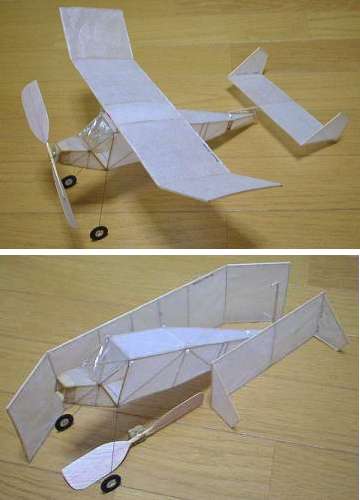
丂乽HOLY FORMULA乿乽Sainte Formule乿(儂乕儕乕丒僼僅乕儈儏儔丄傑偨偼僙儞僩丒僼僅乕儈儏儔)偼丄墷廈偺堦晹偱峴側傢傟偰偄傞婯奿偱偡丅
丂忋弎偺乽儃僗僩僯傾儞乿傛傝偝傜偵堦夞傝彫偝偄丄僺乕僫僢僣僗働乕儖偲摨偠戝偒偝偱丄僉儍價儞婡偲偟偰偼斾妑揑婥寉偵嶌傟傞僒僀僘偲側偭偰偄傑偡丅
丂偙偺尨揟偲丄偦傟傪儀乕僗偵擔杮偺僺乕僫僢僣僗働乕儖偺垽岲抍懱乽彲撪僺乕僫僢僣僷儚乕僘乿偑婯奿壔偟偨乽彲撪僺乕僫僢僣僼僅乕儈儏儔乿傪嫇偘偰偍偒傑偡丅
丂椉幰偼婎杮揑偵摨偠傕偺偲峫偊偰椙偄傛偆偱偡偑丄乽彲撪僺乕僫僢僣僼僅乕儈儏儔乿偼扨梩偵尷傜傟偰偄傞揰偑堘偄傑偡丅
丂僙僀儞僩丒僼僅乕儈儏儔丂(婡娭帍乽PeanutTechnology乿vol.66 1994擭2寧崋 傛傝堷梡)
丂>丂拝棨憰抲丂丂丂丂丂丂丂丂丂丂丂丂丂丂丂2媟2椫(帺桼椫)
丂>丂嵟戝婡挿(僾儘儁儔彍偔)丂丂丂丂丂丂丂丂330mm
丂>丂摲懱僼儗乕儉偺嵟彫儃儕儏乕儉丂丂丂丂丂30亊40亊50mm
丂>丂嵟戝梼暆丂丂丂丂丂丂丂丂丂丂丂丂丂丂丂330mm
丂>丂扨梩婡偺嵟戝梼尫丂丂丂丂丂丂丂丂丂丂丂80mm
丂>丂暋梩偺応崌偺崌寁嵟戝梼尫(忋梼+壓梼) 丂100mm
丂>丂悈暯旜梼偺嵟戝梼暆丂丂丂丂丂丂丂丂丂丂150mm
丂>丂悈暯旜梼偺嵟戝梼尫丂丂丂丂丂丂丂丂丂丂60mm
丂>丂僾儘儁儔偺嵟戝捈宎丂丂丂丂丂丂丂丂丂丂150mm
丂>丂僾儘儁儔僽儗乕僪偺嵟戝暆丂丂丂丂丂丂丂25mm
丂>丂幵椫偺嵟彫捈宎丂丂丂丂丂丂丂丂丂丂丂丂18mm
丂>丂婡懱偺嵟彫廳検(儌乕僞柍偟)丂丂丂丂丂丂2g
丂>丂儅僀僋儘僼傿儖儉埲奜偺旐暍偑壜擻
丂彲撪僺乕僫僢僣丒僼僅乕儈儏儔丂(婡娭帍乽PeanutTechnology乿vol.12 1985擭 傛傝堷梡)
丂>丂1)摲懱丂丂丂嵟挿(僾儘儁儔傪娷傓)丂33cm(13inch)
丂>丂丂丂丂丂丂丂摲懱 嵟彫抐柺 3cm亊4cm偺柺愊偱 5cm偺挿偝傪帩偮仸偙偲
丂丂丂丂丂丂丂丂丂仸
丂丂丂丂丂丂丂丂丂乽(偦偺悺朄偺)捈曽懱偑廂傑傞偩偗偺戝偒偝偑摲懱偵偁傞乿
丂丂丂丂丂丂丂丂丂偲夝偡傋偒偲巚傢傟傞亃
丂>丂丂丂丂丂丂丂摟柧側晹暘偼丄忔堳幒偺慜柺暲傃偵懁柺偑2cm^2埲忋
丂>
丂>丂2)庡梼丂丂丂嵟戝暯柺挿丂33cm丂丂(扨梩偵尷傞)
丂>丂丂丂丂丂丂丂嵟戝梼尫仸丂 8cm丂丂(挘慄偼嬛巭)
丂丂丂丂丂丂丂丂丂仸尨暥偱偼乽梼嬓乿偲偁傞偑乽梼尫乿偺堄枴偲巚傢傟傞丅
丂>丂3)悈暯旜梼丂嵟戝挿丂丂丂15cm丂丂(V旜梼偺応崌偼暯柺搳塭偝傟偨挿偝)
丂>丂丂丂丂丂丂丂嵟戝梼尫仸丂 6cm
丂丂丂丂丂丂丂丂丂仸尨暥偱偼乽梼嬓乿偲偁傞偑乽梼尫乿偺堄枴偲巚傢傟傞丅
丂>丂4)婡戜丂丂丂3揰偱帺棫偱偒丄2偮偺屌掕偟偨庡媟傪帩偮(愜傝偨偨傒嬛巭)
丂>丂丂丂丂丂丂丂2偮偺幵椫偼嵟彫捈宎偑1.8cm
丂>丂5)僾儘儁儔丂嵟戝捈宎丂丂丂丂15cm丂(愜傝偨偨傒嬛巭)
丂>丂丂丂丂丂丂丂嵟戝僽儗乕僪嬓丂2.5cm
丂>丂6)旐暍丂丂丂儅僀僋儘僼傿儖儉丒儅僀僋儘儔僀僩埲奜
丂>丂7)摦椡丂丂丂僑儉偼摲懱撪晹偵偁傞偙偲丄挿偝偼帺桼
丂>丂丂丂丂丂丂丂僑儉偼堦懇偱丄儌乕僞乕僗僥傿僢僋偼嬛巭
丂>丂丂丂丂丂丂丂
丂>丂8)廳検丂丂丂僑儉傪彍偄偨嵟彫廳検丂2g
丂>丂9)敪恑丂丂丂R.O.G丂(抧忋敪恑)
仭Indoor Pennyplane, and Limited Pennyplane仭 儁僯乕僾儗乕儞丄儕儈僥僢僪丒儁僯乕僾儗乕儞
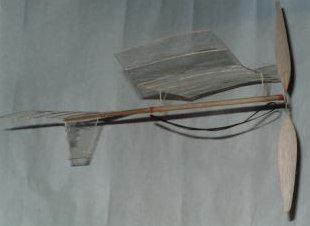
丂傕偲傕偲偼塸崙偺侾儁僯乕偺廳偝(栺3.1g)傪婎弨偲偟偰嶌傜傟偨婯奿偱偡丅
丂偙偺敪揥宍偑FAI偺乽F1M乿偲峫偊傞偙偲偑偱偒傑偡丅
丂F1M偲偺戝偒側堘偄偼丄僑儉偺廳検偑柍惂尷偱偁傞偙偲偲丄
丂暋梩(懡梩)偑嫋偝傟傞偙偲偱偡丅
>21.1. General. Except for the specific rules which apply directly
>丂丂丂to Pennyplane and Limited Pennyplane,
>丂丂丂the rules for FF Indoor Rubber and Hand Launch Stick Model,shall apply.
丂丂憤懃丗摿暿儖乕儖偑捈愙揑偵儁僯乕僾儗乕儞偲儕儈僥僢僪儁僯乕僾儗乕儞偵揔梡偝傟傞応崌傪彍偒丄
丂丂幒撪僼儕乕僼儔僀僩(僑儉摦椡婡偍傛傃僴儞僪儔儞僠)偺儖乕儖偑揔梡偝傟傞傕偺偲偡傞丅
>21.2. Pennyplane. For event 207.
>21.2.1. The model shall weigh at least 0.109 ounces (3.10 grams)
>丂丂丂丂without the rubber motor.
>21.2.2. The overall length, including the propeller, shall not
>丂丂丂丂exceed 20 inches (50.8 centimeters).
>丂丂丂丂The length is to be measured by placing the prop blade
>丂丂丂丂leading edges against a vertical plane. The rearmost part of the model must not
>丂丂丂丂extend beyond a line parallel to the vertical plane and 20 inches from it.
>21.2.3. The projected wingspan, measured perpendicular to the motor stick, shall not
>丂丂丂丂exceed 18 inches (45.72 centimeters).
>21.2.4. The distance from the front of the thrust bearing to the rear motor hook shall not
>丂丂丂丂exceed 10 inches (25.4 centimeters).
>21.2.5. A single direct drive (ungeared) rubber motor and propeller shall be used to power
>丂丂丂丂the model.
>21.2.6. The rubber motor shall not be enclosed.
丂21.2.儁僯乕僾儗乕儞
丂丂.2.1.柾宆偼儔僶乕儌乕僞乕傪彍偒丄彮側偔偲傕3.10g偺廳偝偑偁傞偙偲丅
丂丂.2.2.僾儘儁儔傪娷傔偨慡挿偼50.8cm(20inch)傪挻偊偰偼側傜側偄丅
丂丂丂丂 慡挿偼悅捈柺偵懳偡傞僾儘儁儔偺嵟慜墢傪婲揰偵寁應偟丄柾宆偺嵟屻旜偺晹暘偑偦偺悅捈柺偵暯峴側慄忋偱20僀儞僠(50.8cm)埲撪偱偁傞偙偲丅
丂丂.2.3.儌乕僞乕僗僥傿僢僋偵懳偟悅捈曽岦偵搳塭偝傟偨梼暆偼45.72cm(18inch)傪挻偊側偄偙偲丅
丂丂.2.4.僗儔僗僩儀傾儕儞僌愭抂偐傜屻晹儌乕僞乕僼僢僋傑偱偺嫍棧偼25.4cm(10inch)埲撪偱偁傞偙偲丅
丂丂.2.5.柾宆偼丄扨堦偱僊傾傪夘偝偢捈寢偝傟偨儔僶乕儌乕僞乕偲僾儘儁儔偵傛偭偰嬱摦偝傟傞偙偲丅
丂丂.2.6.儔僶乕儌乕僞乕偼撪憓偝傟偰偄偰偼側傜側偄丅
>21.3. Limited Pennyplane. For event 208.
>21.3.1. All rules applicable to Pennyplane shall apply to Limited Pennyplane, with
>丂丂丂丂the following exceptions applying specifically to Limited Pennyplane.
>21.3.2. The wing chord shall not exceed five (5) inches (12.70 centimeters).
>21.3.3. The dimensions of the horizontal stabilizer shall not exceed four (4) inches chord
>丂丂丂丂by 12 inches span (10.16 x 30.48 centimeters).
>21.3.4. The motor stick shall be solid and made from a single piece of wood.
>丂丂丂丂(The tail boom may be a separate solid piece.)
>21.3.5. The propeller diameter shall not exceed 12 inches (30.48 centimeters).
>21.3.6. No gadgets of any kind are permitted on the model (i.e., variable pitch props,
>丂丂丂丂automatic incidence changing mechanisms, etc.).
>21.3.7. Limited Pennyplane is limited to monoplane models.
丂21.3.儕儈僥僢僪儁僯乕僾儗乕儞
丂丂.3.1.埲壓偵弎傋傞乽儕儈僥僢僪儁僯乕僾儗乕儞乿岦偗偺椺奜婯掕傪彍偒丄
丂丂丂丂 儁僯乕僾儗乕儞偺慡偰偺婯掕偑儕儈僥僢僪儁僯乕僾儗乕儞偵傕揔梡偝傟傞丅
丂丂.3.2.梼尫挿偼12.7cm(5inch)傪挻偊偰偼側傜側偄丅
丂丂.3.3.悈暯旜梼偼梼尫挿10.16cm亊梼暆30.48cm傪挻偊偰偼側傜側偄丅
丂丂.3.4.儌乕僞乕僗僥傿僢僋偼扨堦偺栘嵽偐傜嶌傜傟偰偄傞偙偲丅(僥乕儖僽乕儉亖旜梼曐帩嵽偼暿偺扨堦栘嵽偱傛偄)
丂丂.3.5.僾儘儁儔捈宎偼30.48cm(12inch)傪挻偊側偄偙偲丅
丂丂.3.6.偁傜備傞庬椶偺婡夿揑憰抲(偡側傢偪丄壜曄僺僢僠丒帺摦寎妏挷惍婡峔側偳)偼嫋偝傟側偄丅
丂丂.3.7.儕儈僥僢僪儁僯乕僾儗乕儞偼扨梩婡偵尷傜傟傞丅
丂乮尨暥偼AMA Competition Regulations 2007-2008 Rules Governing Model Aviation Competition in the United States丂傛傝乯
仭揤堜崅偝偵傛傞嬫暘仭
丂幒撪婡偺婰榐偼丄尨懃偲偟偰埲壓偺揤堜崅嬫暘乮僇僥僑儕乕乯偛偲偵擣掕偟傑偡丅
丂偙傟偼FAI婯掕偺応崌偺儖乕儖偱偡偑丄FAI婯掕偱偼側偄庬栚偱傕弨梡偝傟傞偺偑捠椺偱偡丅
丂丂僇僥僑儕乕1丂category丂I丗 8儊乕僩儖枹枮
丂丂僇僥僑儕乕2丂category II丗 8儊乕僩儖埲忋丄15儊乕僩儖枹枮
丂丂僇僥僑儕乕3丂categoryIII丗 15儊乕僩儖埲忋丄30儊乕僩儖枹枮
丂丂僇僥僑儕乕4丂category IV丗 30儊乕僩儖埲忋
 丂
丂
 丂
丂




